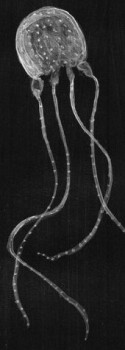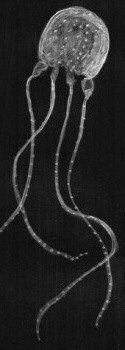Adaptation
Wikimedia Commons: Joe Ravi
.jpg) Body
Structure
Body
Structure
Below, a basic body diagram of Cubozoan jellyfish can be found.
These radially symmetrical jellyfish
have an endoderm and ectoderm, making them diploblastic. These two tissue layers
are separated by mesoglea, a gelatinous material mostly composed of water, which
maintains the structure of the box-shaped bell. The bell is often viewed as the
“top” or “head” of jellyfish that encases all the other structures, excluding
the tentacles. The tentacles, which float beneath the bell, house cnidocytes and
nematocysts: The stinging cells! More information on these small but important
structures can be found further down this page. The pedalium is the flattened
structure which connects a tentacle to the bell. Next to the pedalium, the
epidermis extends to form
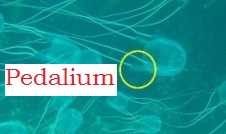 four velarium, one on each side of the boxed bell.
This structure “restricts the size of the opening through which water is
expelled when the bell contracts, thus increasing thrust and making them stron[g]
swimmers” (Hoise 2008). One rhopalium (plural rhopalia) is set within each
velarium, housing up to 6 complex eyes per
Wikimedia Commons: Peter Southwood
rhopalium. This means that these tiny
jellies can have up to 24 eyes! You can learn more about the eye structure and
just how well C. barnesi can see further down this page. The mouth and
anus (remember this organism only has one opening that does double-duty!) is
centered on the underside of the bell. This allows for ideal movement of prey
from the tentacles to the mouth for consumption. Now let’s move to the inside of
the Irukandji! The gastric cavity, or coelenteron, is directly
four velarium, one on each side of the boxed bell.
This structure “restricts the size of the opening through which water is
expelled when the bell contracts, thus increasing thrust and making them stron[g]
swimmers” (Hoise 2008). One rhopalium (plural rhopalia) is set within each
velarium, housing up to 6 complex eyes per
Wikimedia Commons: Peter Southwood
rhopalium. This means that these tiny
jellies can have up to 24 eyes! You can learn more about the eye structure and
just how well C. barnesi can see further down this page. The mouth and
anus (remember this organism only has one opening that does double-duty!) is
centered on the underside of the bell. This allows for ideal movement of prey
from the tentacles to the mouth for consumption. Now let’s move to the inside of
the Irukandji! The gastric cavity, or coelenteron, is directly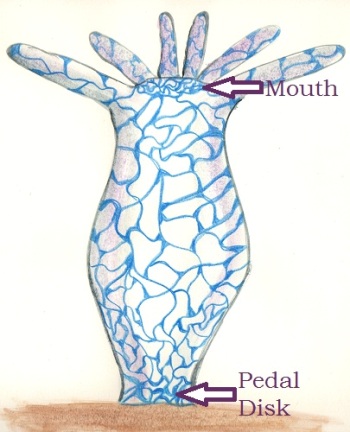 inside of the
mouth/anus area. This structure, which is lined with endoderm tissue, breaks
down food via extracellular digestion. The gonads (sperm and egg forming organs)
in this dioecious organism surround the outside of the gastric cavity.
Underneath the bell’s tissue is the radial canal. This structure is responsible
for transporting nutrients throughout the entire bell. Now you may be thinking,
“So there are reproductive and digestive organs, but what about blood, or even a
brain?” Good question! The answer is simple: There is no blood. There is no
brain. Jellyfish are made up of 95% water which allows for lots of diffusion in
order to receive
Diagram made by
Kelsey Lyons
necessary gases for respiration, and with the addition of the
radial canal moving nutrients from food throughout the body, the need for blood
is eliminated. As for the lack of a brain, all Cnidaria have what is called a
nerve net (diagram of a nerve net above). Sensory nerves are distributed relatively equally (with some
concentration around the pedal disc during the polyp phase and the mouth/anus)
in a net like pattern.
inside of the
mouth/anus area. This structure, which is lined with endoderm tissue, breaks
down food via extracellular digestion. The gonads (sperm and egg forming organs)
in this dioecious organism surround the outside of the gastric cavity.
Underneath the bell’s tissue is the radial canal. This structure is responsible
for transporting nutrients throughout the entire bell. Now you may be thinking,
“So there are reproductive and digestive organs, but what about blood, or even a
brain?” Good question! The answer is simple: There is no blood. There is no
brain. Jellyfish are made up of 95% water which allows for lots of diffusion in
order to receive
Diagram made by
Kelsey Lyons
necessary gases for respiration, and with the addition of the
radial canal moving nutrients from food throughout the body, the need for blood
is eliminated. As for the lack of a brain, all Cnidaria have what is called a
nerve net (diagram of a nerve net above). Sensory nerves are distributed relatively equally (with some
concentration around the pedal disc during the polyp phase and the mouth/anus)
in a net like pattern.
Eyes
As stated above, C. barnesi can have up to 24 eyes! In each
rhopalium (painted orange on the diagram below), of the possible six eyes present, 4 are simply sensitive to light
(similar to the eyespots of
Maritigrella crozieri and other tubullaria) but
the other two are rather complex
(Collins 2000). So that means the box jellyfish can have up to 16 simple
eyes and 8 complex eyes! These 8 complex eyes have lenses, corneas, and retinas
that enable these jellyfish to distinguish different levels of light and form
actual images, however, not to the same degree that you and I can
(Hosie 2008).
They can make out very clear shapes, but because “the focal length is longer
than the distance between the lens and the retina”
(Hosie 2008) box jellyfish
are completely far-sighted: only able to see clear farther away, while images
closer to the eyes appear very out of focus. Also, these eyes don’t just stay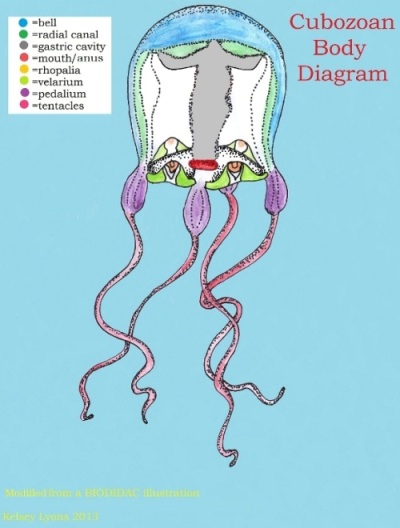 fixed in one spot! “A cubozoan can look both inward towards its mouth
and…outward,” explains Allen Collins from UCMP. Collins also describes other
fascinating structures within these eyes:
fixed in one spot! “A cubozoan can look both inward towards its mouth
and…outward,” explains Allen Collins from UCMP. Collins also describes other
fascinating structures within these eyes:
“Inside
each rhopalium, located below the eyes, is an organ called astatocyst. Inside each astatocyst is a hard nodule
composed of calcium sulfate, the statolith. Statoliths appear to
have daily growth rings. The statocysts are
sensitive to orientation, and thus allow cubozoans to sense whether they are upside-down, sideways, or right side-up.”
Diagram Made by Kelsey Lyons
Cnidocytes and Nematocysts
These are cells that have come to define jellyfish. On the tentacles, there
are cnidocytes with small triggers, and within those, are the spring loaded,
harpoon-like nematocysts. What separates the Irukandji from other box jellyfish
is that they have these stinging cells on their bell as well! When a trigger is
touched, even if it is a light brush, the nematocyst will shoot out from the
cnidocyte and into the unfortunate being that touched the trigger. This reaction
is almost instantaneous. These videos are of actual nematocysts being stimulated
and then firing; you are able to see the incredible speed.
http://www.youtube.com/watch?v=6zJiBc_N1Zk
http://www.youtube.com/watch?v=rNJC0FI4aSs
The tip of this structure has
barbs which enable it to remain embedded the prey (or person) while venom is
being ejected. As the second video above states, another difference between C. barnesi and other box jellyfish is the manner of release of this venom: rather
than being released by the entire cell, it is released only from the tip (which
explains the delayed reaction in humans in Irukandji Syndrome).
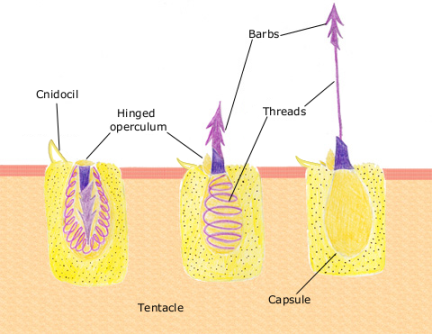
Here is a
diagram illustrating the different phases of these stinging cells. The first is
unreleased, the second shows nematocyst beginning to fire, and the third
illustrates a fully released and extended nematocyst.
Wikimedia Commons: Spaully
Venom
This paralyzing adaptation has allowed C. barnesi to survive over the years. Although this quality has been labeled as horrible and menacing by humans, due to Irukandji Syndrome, it has been extremely beneficial for this jelly. Such a small and delicate organism would typically have little to no chance surviving in this world, let alone the diverse, and at times dangerous, Australian waters, but because of their ability to paralyze their prey, thus saving a large amount of energy, they are able to not just survive, but thrive. If you'd like to learn about what this venom does to paralyze organisms and even read about a research project with the venom, follow this link to the Irukandji Syndrome page.
Next stop: Nutrition
UW-L
Last Updated: April 26, 2013
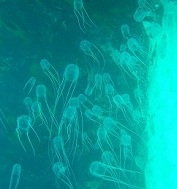
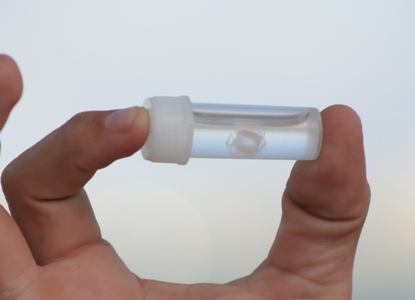
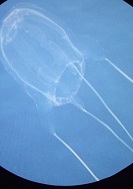
Wikimedia Commons: Peter Southwood
Wikimedia
Commons: GondwanaGirl
Wikimedia Commons: Zaneta Nemcokova
